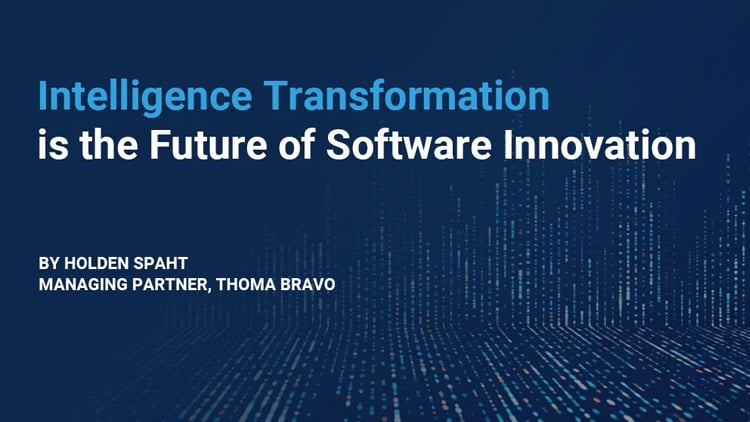
Our business at Thoma Bravo is conceptually simple: we transform great innovators into great companies. Executing on that promise is complex — even more so today as AI rapidly changes the meaning of both sides of the equation. "Great innovators" are being redefined by a major evolution in technology, and "great companies" are being reshaped by new possibilities for radical value creation through deep, dynamic business intelligence.
Right now, businesses are investing and experimenting with AI and, in doing so, defining multiple pathways to unlock new opportunities. As I observe this transformation across our portfolio and the broader market, I see two distinctive paths emerging for software companies in particular — vertical intelligence segments and horizontal intelligence systems — with each presenting very different investment propositions.
Two Pathways to AI-Enabled Value Creation in Software
Pathway 1: Vertical Intelligence Segments
Imagine an AI-native start-up that aims to serve a common interior design need by automating room visualization. The start-up's software can generate photorealistic renderings of any space with different paint colors, furniture arrangements, and lighting schemes. The technology is impressive: you upload a photo of the living room, specify your preferences, and within seconds see dozens of professional-quality design options. You might then be able to buy the components you need to transform your room into the design you like directly from the image.
This is now a familiar story of AI-native companies focusing on specific vertical slices of a business stack. They typically aim to make existing functions (like renovating a room) dramatically more efficient through targeted automation. This neo-design company almost certainly hasn’t built its own model — it relies on multimodal AI models built by others, which the developer team "wraps" and fine-tunes for the specific use case. They don't require deep pre-existing datasets or a comprehensive understanding of broader business technology stacks; it's more about ensuring compatibility and interoperability with a few systems that directly connect to the product (in this case, perhaps that’s the inventory and ordering systems for the most common home furnishing suppliers).
The common thread among companies like this is to serve as a "force multiplier" that either augments existing human capabilities or disintermediates them altogether; you can envision an interior designer using the app as a new tool to bring their vision to life for their clients, or furniture sellers going direct-to-consumer as users skip the designer (and their finder fees) altogether.
We're witnessing a new “Cambrian explosion” of such firms that is accelerating over 2.4x faster than during the peak of the dot-com boom (when the term Cambrian explosion was a popular way to describe new business creation). Between 2013 and 2024, 6,956 AI companies were funded in the U.S., with 1,073 funded in 2024 alone. The chart below shows data through 2022, but the AI startup boom has intensified even further since then.

Source: U.S. Census Bureau’s 2022 Business Dynamics Statistics Datasets (1)
Of course, not all will survive.
Dot-com firms had five-year survival rates approaching 50%. Today's AI startups appear to face even bleaker odds – industry experts predict that 85% will be out of business within three years. A recent survey of 100 founders conducted in 2023 was even more pessimistic, with a staggering 92% of the AI and tech businesses marked for failure.
The real numbers will take years to settle, and the technology itself is moving at breakneck speed that changes the competitive landscape for these businesses seemingly by the day. But while it may be too early to make sweeping declarations about 9 of 10 AI businesses being destined for failure, trendlines and a simple market analysis expose a harsh reality facing vertical firms.
Many will face similar competitive and business model challenges that led to the downfall of vertically-oriented dot-com firms. Consider the iconic example of Pets.com, a dot-com highflier that “solved” for end-users the single vertical problem of having to continuously stock their pantries with heavy bags of pet food. Like Pets.com, many of today’s vertical AI startups won’t have deep competitive moats in their technology or in their markets. While Pets.com burned cash paying for free overnight delivery of those heavy bags, vertical AI startups burn cash to pay for access to the underlying foundation models, which are available to competitors as well. Competing products are relatively easy to build, particularly since much of the “wrapper” software code that turns a model into a simple vertical product can now be written by machines. And a new entrant doesn’t have to have a deep understanding of the market ecosystem it is trying to penetrate, it just needs to identify a specific “pain point” in the process and focus its effort in that one place.
Pathway 2: Horizontal Intelligence Systems
Now, imagine a different approach to the interior design world: a comprehensive design/build platform serving the whole elaborate ecosystem of homeowners, contractors, architects, suppliers, and home furnishing companies. The company taking this approach will leverage deep datasets across millions of projects to enable capabilities that span the entire design and construction value chain, aiming to predict which cabinet styles will be timeless versus trendy. It understands regional building code requirements. It can optimize supply chain logistics and provide dynamic pricing based on material availability. It can identify, negotiate a price, and schedule a well-practiced installer. And it can configure a set of drawers based on what it knows about the usage and living patterns of the people who will occupy the room.
While the AI-native vertical startup might excel at generating beautiful room visualizations, this horizontal intelligence platform addresses the complexity of the interior design process that often frustrates participants in the ecosystem by centering decisions and interactions around a deeper understanding of the customer’s real needs. Ideally, kitchen cabinets should open smoothly without collision, complement the homeowner's cooking habits and entertaining style, comply with local building codes, be designed around existing electrical outlets and plumbing fixtures to ensure accessibility and functionality, and reflect both current trends and enduring appeal.
An AI-native startup might aspire to this kind of ecosystem coverage, but it’s a long and complex road to get there when you start with only the room visualization capability at hand. The easier and faster road belongs to today's enterprise software companies, who may already have the requisite data to address enterprise infrastructure, data management, and logistics. And while those “details” may be less glamorous than a flashy room visualization, as anyone who has done a home renovation knows all too well, the success of any project hinges on plumbing, permits, and patterns of human behavior much more than it does on a coat of paint.
Similarly, it’s the success of complex horizontal intelligence systems that can power global business transformation at a meaningful scale — and these horizontal, enterprise-level SaaS systems represent the kinds of software intelligence capabilities we've been identifying and building at Thoma Bravo for decades. The incorporation of AI capabilities supercharges their ability to infer complex business intelligence and execute on the insights. Consider Coupa Software's procurement intelligence across $6 trillion in transaction data, Proofpoint's collective cybersecurity defense networks, or Anaplan's connected planning platform that learns from thousands of business scenarios.
The horizontal enterprise approach goes beyond efficiency offered by a single vertical function, toward relationships and synergistic efficiencies between many functions, ultimately unlocking new business insights through enterprise-wide horizontal intelligence.
These firms aren’t really a bet on automating existing processes (though they do that along the way). They represent a bet that is tilted heavily toward innovation — enabling customers to do fundamentally new things. This approach is built on deep data sets, a comprehensive understanding of full business technology stacks, and a customer service mentality that recognizes the importance of compliance, scale, legal requirements,
The Strategic Difference
Consider how this might play out in practice in another home design example. A company like Sherwin-Williams might build (or more likely acquire) an AI app that tests paint swatches against room photos. A company like Restoration Hardware, or an integrated architectural firm like Arup or Gensler, might pursue a horizontal business ecosystem approach and extend existing SaaS systems to combine decades of color science with real-time trend intelligence and predictive models on customer preferences, creating a platform that doesn't just visualize paint colors but predicts which palettes will resonate with specific demographics, complement architectural styles, and maintain appeal over time.
It’s not just a thought experiment in home design: the strategic difference is equally visible in today’s quickly evolving software engineering practices. Now, imagine designing a codebase for a complex enterprise product, rather than a living room. While AI can now automate many coding tasks — making raw code increasingly a commodity — this shift places greater emphasis and value on everything else other than raw code that a modern software company provides to an enterprise customer. We might at one point stop calling such companies “software” companies altogether since what they're really selling is the ability to unpack complex business problems and design continuously evolving digital solutions empowered by AI.
This is the definition of modern business intelligence — and thus of the intelligence transformation that's emerging. It is likely going to be executed in code, but it isn't really code per se. It's the problem-solving function, at scale and in silicon.
“We might at one point stop calling such companies ‘software’ companies altogether, since what they're really selling is the ability to unpack complex business problems and design continuously evolving digital solutions empowered by AI.”
Investment Implications
Both pathways represent legitimate routes to value creation, but they present fundamentally different risk profiles and investment propositions.
Pathway 1 — the vertical specialists — will see higher rates of both birth and death, following more of a venture capital model with a few big successes and many failures. Some of these companies may build such large vertical markets that they can continue to grow for a long while. Some may be incorporated into horizontal platforms through hundreds of millions to low billions of dollars in acquisitions, as VCs cash in on successful bets. A very small number of them may be able to extend vertical success into the horizontal business ecosystem plane – though that is a very difficult proposition in practice and will probably be exceedingly rare.
Pathway 2 — the horizontal ecosystem innovators — will typically involve larger, more established firms, but for those that successfully harness AI's potential, the scale and impact can be enormous. The $10+ billion mega-deals will likely happen here, as strategic M&A heats up around horizontal intelligence platforms. The more enterprises integrate AI, the more assurance, compliance, security, and crystal-clear ROI matter — all areas with little room for error that heavily favor today's established SaaS providers.
At Thoma Bravo, we’re watching developments in Pathway 1 with interest, but we're placing more of our investment focus in Pathway 2 because we believe that is where the greatest and most sustainable businesses will be built. Investors who frame AI as a threat to the SaaS business model seem to miss this point, and thus risk missing that some of the most significant opportunities will emerge at the intersection of technical innovation and business intelligence — where tools become solutions and efficiency transforms into insight.
Great innovation, plus operational excellence, has always been our formula. In the intelligence transformation era, that means backing companies that do more than just automate existing processes, but fundamentally reimagine what's possible when human insight combines with artificial intelligence built on massive data collected, organized, and learned from at a significant scale.
Originally published on LinkedIn












